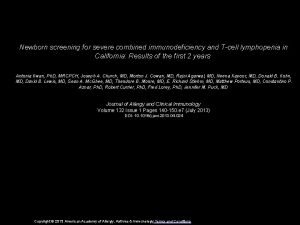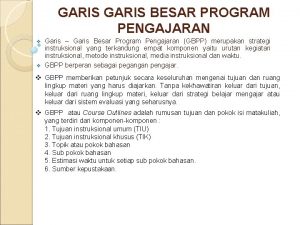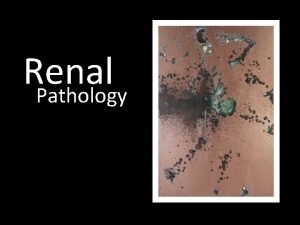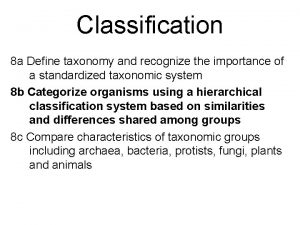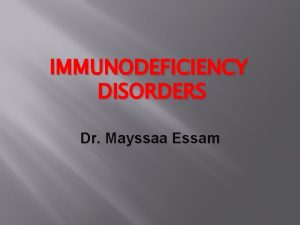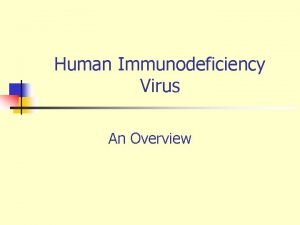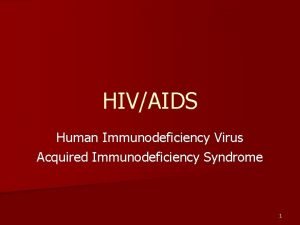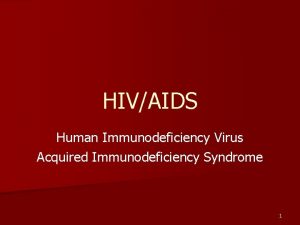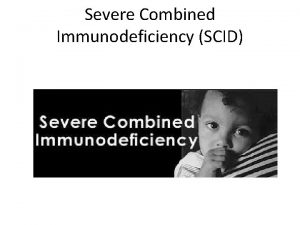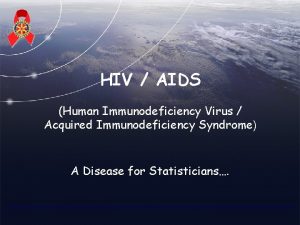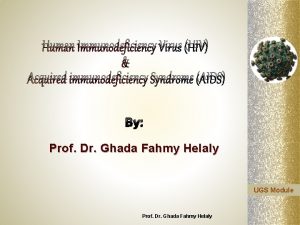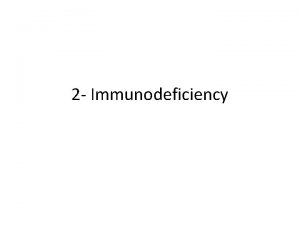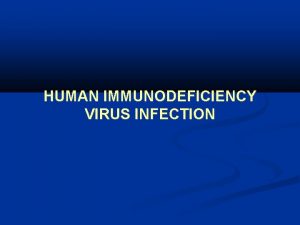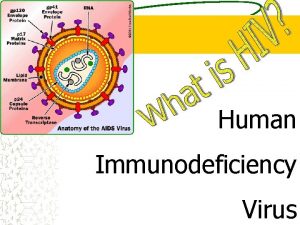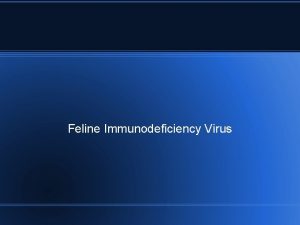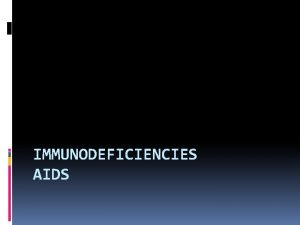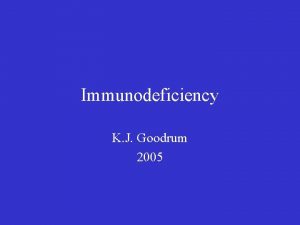IMMUNODEFICIENCY Lecture Outlines v Define immunodeficiency v Classification




























- Slides: 28

IMMUNODEFICIENCY Lecture Outlines v. Define immunodeficiency v. Classification v. Specific non specific v. Primary and secondary v. B cell deficiency & Examples v. T Cell deficiency & Examples v. SCID v. Drug induced immunodeficiency


• It is the absence or failure of normal function of one or more elements of the immune system • Results in immunodeficiency disease • Can be specific or non specific Specific = Abnormalities of B & T cells Non specefic = Abnormalities of non specific components PRIMARY OR SECONDARY

PRIMARY IMMUNODEFICIENCIES v. Primary immunodeficiencies are inherited defects of the immune system v These defects may be in the specific or nonspecific immune mechanisms v. They are classified on the basis of the site of lesion in the developmental or differentiation pathway of the immune system

B CELL DEFICIENCY ü X liked a gammaglobuinemia ü Ig. A deficiency ü Ig. G subclass deficiency ü Immunodeficiency with increased Igm ü Common variable immundeficiency ü Transient hypogammaglobulinaemia of infancy

1 - X-linked a gammaglobulinaemia v. In X-LA early maturation of B cells fails v. Affect males v. Few or no B cells in blood v. Very small lymph nodes and tonsils v. No Ig v. Small amount of Ig G in early age v. Recurrent pyogenic infection

2 - Ig. A and Ig. G subclass defeciency v. Ig. A deficiency is most common v. Patients tend to develop immune complex disease v. About 20% lack Ig. G 2 and Ig. G 4 v. Susceptible to pyogenic infection v. Result from failure in terminal differentiation of B cells

3 - Immunodfeiciency with increased Ig. M (HIg. M) v Results in patients with Ig. A and Ig. G deficiency v Production of large amount of Ig. M >200 mg/dl of polyclonal Ig. M v Susceptible to pyogenic infection v Treatment by iv gamma globulin v Formation of Ig. M to neutrophils, platelets and other blood components v Due to inability of B cells to isotype switching

4 - Common Variable Immunodeficiency (CVID) v There are defect in T cell signaling to B cells v Acquired a gammaglobulinemia in the 2 nd or 3 rd decade of life v May follow viral infection v Pyogenic infection v 80% of patients have B cells that are not functioning v B cells are not defective. They fail to receive signaling from T lymphocytes v Unknown

5 - Hypogamaglobulinaemia of infancy v. Due to delay in in Ig. G synthesis approximately up to 36 months v. In normal infants synthesis begins at 3 months v. Normal B lymphocytes v. Probably lack help of T lymphocytes

DISORDERS of T CELLS • Di. George's syndrome: v It the most understood T-cell immunodeficienc v Also known as congenital thymic aplasia/hypoplasia v Associated with hypoparathyroidism, congenital heart disease, fish shaped mouth. v Defects results from abnormal development of fetus during 6 th-10 th week of gestation when parathyroid, thymus, lips, ears and aortic arch are being formed

T cell deficiencies with variable degrees of B cell deficiency 1 - Ataxia-telangiectasia: • Associated with a lack of coordination of movement (ataxis) and dilation of small blood vessels of the facial area (telangiectasis). • T-cells and their functions are reduced to various degrees. • B cell numbers and Ig. M concentrations are normal to low.

• Ig. G is often reduced • Ig. A is considerably reduced (in 70% of the cases). • There is a high incidence of malignancy, particularly leukemia in these patients. • The defects arise from a breakage in chromosome 14 at the site of TCR and Ig heavy chain genes

2 - Wiskott-Aldrich syndrome: • Associated with normal T cell numbers with reduced functions, which get progressively worse. • Ig. M concentrations are reduced but Ig. G levels are normal • Both Ig. A and Ig. E levels are elevated. • Boys with this syndrome develop severe eczema. • They respond poorly to polysaccharide antigens and are prone to pyogenic infection.

MHC DEFICIENCY (Bare leukocyte syndrome): • Due to defect in the MHC class II transactivator (CIITA) protein gene, which results in a lack of class-II MHC molecule on APC. • Patients have fewer CD 4 cells and are infection prone !. • There also individuals who have a defect in their transport associated protein (TAP) gene and hence do not express the class-I MHC molecules and consequently are deficient in CD 8+ T cells.

Defects of the phagocytic system Defects of phagocytic cells (numbers and/or functions) can lead to increased susceptibility to a variety of infections. 1 - Cyclic neutropenia: It is marked by low numbers of circulating neutrophil approximately every three weeks. The neutropenia lasts about a week during which the patients are susceptible to infection. The defect appears to be due to poor regulation of neutrophil production.

2 - Chronic granulomatous disease (CGD): CGD is characterized by marked lymphadenopathy, hepato- splenomegaly and chronic draining lymph nodes. • In majority of patients with CGD, the deficiency is due to a defect in NADPH oxidase that participate in phagocytic respiratory burst.

3 - Leukocyte Adhesion Deficiency: o Leukocytes lack the complement receptor CR 3 due to a defect in CD 11 or CD 18 peptides and consequently they cannot respond to C 3 b opsonin. o Alternatively there may a defect in integrin molecules, LFA-1 or mac-1 arising from defective CD 11 a or CD 11 b peptides, respectively. o These molecules are involved in diapedesis and hence defective neutrophils cannot respond effectively to chemotactic signals.

4 - Chediak-Higashi syndrome: • This syndrome is marked by reduced (slower rate) intracellular killing and chemotactic movement accompanied by inability of phagosome and lysosome fusion and proteinase deficiency. • Respiratory burst is normal. • Associated with NK cell defect, platelet and neurological disorders

Disorders of complement system: v Complement abnormalities also lead to increased susceptibility to infections. v There are genetic deficiencies of various components of complement system, which lead to increased infections. v The most serious among these is the C 3 deficiency which may arise from low C 3 synthesis or deficiency in factor I or factor H.

SEVERE COMBINED IMMUNODEFICENCY Ø In about 50% of SCID patients the immunodeficiency is x-linked whereas in the other half the deficiency is autosomal. Ø They are both characterized by an absence of T cell and B cell immunity and absence (or very low numbers) of circulating T and B lymphocytes. Ø Patients with SCID are susceptible to a variety of bacterial, viral, mycotic and protozoan infections.

Ø The x-linked SCID is due to a defect in gamma-chain of IL-2 also shared by IL-4, -7, -11 and 15, all involved in lymphocyte proliferation and/or differentiation. Ø The autosomal SCIDs arise primarily from defects in adenosine deaminase (ADA) or purine nucleoside phosphorylase (PNP) genes which results is accumulation of d. ATP or d. GTP, respectively, and cause toxicity to lymphoid stem cells

Diagnosis Is based on enumeration of T and B cells and immunoglobulin measurement. Severe combined immunodeficiency can be treated with bone marrow transplant

SECONDARY IMMUBODEFICIENCY

IMMUNODEGECIENCY CAUSED BY DRUGS CORTICOSTEROIDS Ø Cause changes in circulating leukocytes Ø Depletion of CD 4 cells Ø Monocytopenia Ø Decreased in circulating eosinophils and basophils Ø Inhibition of T cell activation and B cell maturation Ø Inhibit cytokine synthesis

METHOTREXATE Ø Structural analogue of folic acid Ø Blocks folic acid dependent synthetic pathways essential for DNA synthesis Ø Prolonged use for treatment reduces immunoglobulin synthesis

CYCOLOSPORIN Ø Have severe effects on T cell signaling and functions Ø It binds to immunophilins which are believed to have a critical role in signal transduction Ø Also inhibit IL 2 dependent signal transduction

OTHER CAUSES ü Malnutrition ü Minerals ü Vitamins ü Obesity
 Monocyte derived dendritic cells
Monocyte derived dendritic cells Combined immunodeficiency
Combined immunodeficiency 01:640:244 lecture notes - lecture 15: plat, idah, farad
01:640:244 lecture notes - lecture 15: plat, idah, farad What is an outline? *
What is an outline? * Teaching outline
Teaching outline Kairos talk outlines
Kairos talk outlines Commercial law outlines
Commercial law outlines Four main components for effective outlines
Four main components for effective outlines A business plan is a document that outlines
A business plan is a document that outlines Pathology outline
Pathology outline Elijah and the shunammite woman
Elijah and the shunammite woman Anime outlines
Anime outlines Two types of outlines
Two types of outlines A haunted house by virginia woolf characters
A haunted house by virginia woolf characters Ksf outlines
Ksf outlines Mucoepidermoid carcinoma histology
Mucoepidermoid carcinoma histology Cmmi model outlines
Cmmi model outlines Outline of the book of acts by chapter
Outline of the book of acts by chapter Exegetical outline
Exegetical outline Level 3 cjis security test
Level 3 cjis security test Model un position paper outlines
Model un position paper outlines Define:visible
Define:visible Congestion intestinal
Congestion intestinal Disaster management in libraries and information centres
Disaster management in libraries and information centres Bayesian classification in data mining lecture notes
Bayesian classification in data mining lecture notes Six kingdom classification
Six kingdom classification Eager vs lazy
Eager vs lazy Qualitative classification in statistics
Qualitative classification in statistics Traditional classification vs modern classification
Traditional classification vs modern classification

